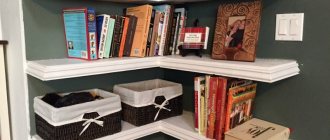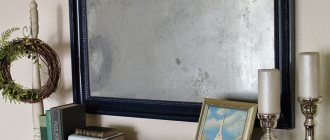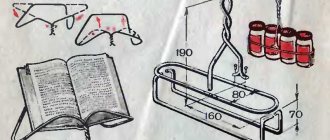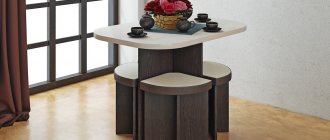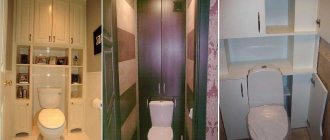Author: Dimon
01 June 2021 13:41
Community: Facts
Tags: interesting informative facts
7506
7
In matters of appearance, we focus primarily on our reflection in the mirror. But does it tell the truth? We'll figure out…
0
See all photos in the gallery
Main secrets
Manufacturer's certificate.
Mirrors for the home are not subject to mandatory certification, so there may not be a certificate of conformity issued by a government certification body. But the manufacturer’s certificate, which indicates the materials used in the manufacture of the mirror, must always be available. Ask the seller!
How to identify a crooked mirror.
In the store, quickly walk past the mirror, looking at yourself: the reflection should not ripple on the glass, “float”, or become distorted. Another little secret of choice: place your hand with a pencil or ruler perpendicular to the mirror and move it in front of it in different directions. If the surface of the mirror is curved, the image will lag slightly.
In the photo: Look mirror from the Bonaldo factory.
The thicker the better.
Cheap and thin mirrors may have an uneven surface, and the image in such a mirror may have incorrect proportions. We recommend looking at mirrors with glass thickness from 4 to 6 mm: the larger, the better and more expensive the mirror. Good mirrors are made from sheet silicate glass of the three highest grades (M1 - mirror improved, M2 - mirror, M3 - polished window).
Smoothness is a good sign.
It is important to inspect the mirrors for scratches, stains, spots and unevenness. Air bubbles frozen in the mirror surface should be especially alert. However, any flaw that is insignificant at first glance is a sign of low quality.
Only the absence of even the slightest flaw on the surface of the mirror indicates the excellent quality of the product.
Mirror 307 Opera from Longhi factory.
What is the product
Mirror reflections help analyze appearance and inspect the surroundings. In ancient times, people could only see their reflection on the surface of the water. The modern product consists of glass and a reflective layer. The production of models in this form began relatively recently. Previously, people used other devices:
- polished metal plates;
- polished semi-precious stones;
- polished gems.
Any materials that had a high degree of reflectivity were used. The Industrial Revolution gave impetus to the development of mirror production technologies. Glass base, spraying or reflective material, frame - the standard design has survived to this day.
Archaeologists have found the first prototypes of mirrors inside the ruins of palaces and tombs. The frames were made of ivory or semi-precious stones and inlaid with pearls.
Modern reflective products are produced using standard technology. Three methods are popular:
- spraying amalgam, aluminum, titanium, and various alloys onto glass;
- creating mirrors from a solution of silver with copper and chemicals;
- deposition of silver on a celluloid surface.
The product created in production consists of glass, amalgam, protective paint and frame. The latter directly affects the cost. Often, cleaned glass and raw materials for sputtering are produced in the same plant. Mirrors are created from the following components:
- soda;
- dolomite;
- glass fragments;
- coal;
- sand quartz.
Regardless of how the mirror is made, the composition remains virtually unchanged. Silver or titanium oxide is prepared for spraying. A smooth glass sheet should have the smoothest possible surface and a high level of cleaning. All cooled layers are checked for defects before spraying is applied.
How and how to wash a mirror without streaks at home, top tips
The structure of the mirror plate
Coating
Look behind the mirror.
Moisture resistance and reflective properties depend on the quality of the protective coating on the reverse side. Good mirrors consist of a glass sheet and three layers of coating. The first is reflective (made of silver, as we found out). The second is protective (a film against corrosion, usually made of copper, and in the new generation of environmentally friendly high-quality mirrors - made of neutral metals). The third is also protective (two or three layers of paint in cheaper options and a polymer coating in more expensive ones), protecting against mechanical damage and moisture.
Silver is the best option.
Today, the most common coating is silver microfilm with a thickness of 0.15-0.30 microns. A cheaper option is aluminum, it is less durable, and its reflection coefficient is worse (maximum 0.77 versus 0.85-0.87 for silver mirrors). However, aluminum mirrors are now no longer produced. So, if you are not planning to buy an antique mirror (previously gold or bronze was added to the amalgam, so it is worth looking at mirrors in antique salons: they emit a soft glow, refresh and make you look younger), then the only option is a mirror with a silver coating.
Antique mirrors (in aged frames and with the effect of aged glass) are made using the eglomise technique - decorating (or painting) on the inside of the glass.
- Mirror JRM-0468 Antique Round from John-Richard factory.
- Mirror 492094 Oyster Mirror (Églomisé) from Jonathan Charles Fine Furniture.
- Mirror 1253 from the Chelini factory.
- Mirror Carreaux 82043c4 from Du Bout Du Monde.
Mirror production
Sheets of glass
for mirrors A mirror requires a base, which consists of a flat sheet of glass. All components necessary for its production are ground and thoroughly mixed until a homogeneous powder is obtained - glass batch. It is moved along a conveyor belt into a furnace, where it melts into a homogeneous liquid glass mass. It is baked at temperatures above 1500°C to be able to obtain a smooth surface. A web 3-4 meters wide with a thickness of about 4 mm comes out of the oven and is sent to the cutting stage. The cooled glass is cut and checked for defects. Suitable sheets are sent to the metal deposition stage, and rejected ones are sent for recycling.
Glass polishing for mirrors
To obtain a reflective surface on a glass base, it is necessary to apply a chemical solution using a special technology. The glass is polished with brushes and a perfectly smooth surface is obtained. It is washed from dust, dried and a chemical composition is applied using a spray bottle. Over the course of 20 seconds, oxidation of aldehydes occurs with an ammonia solution of silver oxide. As soon as the chemical reaction is completed and the solution dries, a mirror surface is formed on the reverse side.
The quality control inspector uses a directional light to check each mirror for defects. To protect against accidental damage, dark green paint is applied to the reflective layer. The dried fabric is finally checked for defects and minor damage, after which it is packaged and sent to the customer.
Fun fact : The first timely mirror was designed and mass produced in 1279. It was invented by the Italian Franciscan monk John Peckham, who conducted experiments with glass and metals. He coated a piece of clear glass with a thin layer of liquid tin, resulting in the prototype of a modern mirror.
For a person at all times, a mirror has been an assistant in establishing social relationships. Previously, it was made of polished metal, coated the glass with tin or silver and always strived to get the perfect reflection. The technology has gradually developed, as a result of which today you can buy a mirror with a 99% reflective surface, which was previously an unthinkable dream. But few people realize the secrets of their mirror when they once again see their ideal reflection in it.
Interesting: Why do people get sick, what are microbes and why do they give injections? Photo and video
Extreme sides
The edge requires special treatment.
The wider the edge and the more complex its configuration, the more interesting the mirror looks. But the edges of the mirror and glass are processed not so much for decoration as to protect the coating layers. Therefore, the strength and durability of the mirror depends on how correctly this process was carried out. We present various types of edge processing as the cost of this operation increases.
- Cleaning up.
Removing a sharp cutting edge. - Simple processing.
The edge is processed until a safe rounded edge is obtained. - Polishing.
The edge is transparent, trapezoidal in shape. - Grinding.
The edge is matte, trapezoidal in shape. - Bevelling.
A facet (facet) is a polished chamfer, beveled at an angle to the mirror surface.
The bevel gives the mirror a finished look and decorates it with the play of light on its edges.
Mirror JRM-0574 Leathered Keyhole by John-Richard.
Proper installation as a way to protect against moisture
The mirror can be protected from harmful influences using some methods of attachment to the base:
- The mirror sheet can be attached tightly to a flat surface - a wall, a wooden or plastic panel using liquid nails. The cracks along the edge are sealed using any suitable sealant, for example, silicone. Then the mirror is placed on the wall of the room.
The mirror is mounted on a flat base
- Another installation method is directly on the wall or in a niche, flush with the finishing tiles. In this case, you can attach a mirror sheet to the wall using tile adhesive.
Niche for subsequent installation of the mirror flush with the tiles
What types of mirrors are there?
Traditional.
Such mirrors are colorless; as mentioned above, they are made using silver or (now rarely) aluminum film.
Colored.
Mirrors using a reflective layer of golden, gray, gold, blue or emerald shades can add liveliness and originality to any interior. Separately, it is worth mentioning quite expensive artificially aged mirrors and chameleon mirrors, which change their color depending on the viewing angle (you can look at mirrors for a long time: one color smoothly transitions into another).
In the photo: mirror Gli Specchi Di Dioniso from Glas italia.
Matte.
Mirrors with a muted shine. The decorative effect is achieved through engraving, silk-screen printing and matting of the polished surface.
"Spy"
On the one hand they look like transparent glass, on the other - like an ordinary mirror that does not let the eye through. The name is long: “tinted canvas with a one-way mirror effect.”
My light, mirror, tell me...
Everyone in childhood visited the so-called laughter room or watched the fairy tale about the Kingdom of Crooked Mirrors, so no one needs to explain how reflection changes on a convex or concave surface. The effect of curvature is also present in smooth, but very large mirrors (with a side of ≥1 m). This is explained by the fact that their surface is deformed under its own weight, so large mirrors are made from sheets at least 8 mm thick.
0
But the ideal quality of a mirror does not guarantee its “truthfulness” for an individual. The fact is that, even having a perfectly smooth mirror that very accurately reflects external objects, a person will perceive a reflection with defects due to his individual characteristics. What we are accustomed to thinking of as our reflection is not actually it - it is just a visual projection that manifests itself in the subcortex of the brain, thanks to the work of the complex human perception system. In fact, perception largely depends on the function of the organs of vision (the human eye that looks in the mirror) and the work of the brain, which transforms incoming signals into an image. How else can one explain the visual dependence of reflection distortion on the shape of the mirror?! After all, everyone knows that elongated (rectangular and oval) mirrors make you look slimmer, while square and round ones make you look fatter. This is how the psychology of perception of the human brain works, which analyzes incoming information, linking it to familiar objects and forms.
Installation Requirements
Decide on a location.
The mirror is glued once and forever; it cannot be removed. Therefore, if you are prone to change, give up glue in favor of special fittings. A standard set for hanging frameless mirrors requires two strong mounting points and a perfectly straight hanger relative to the wall.
The special metal frame of this mirror allows it to be mounted in horizontal, vertical and inclined positions.
- Mirror The Wing by Fiam.
- Mirror The Wing by Fiam.
- Mirror The Wing by Fiam.
- Mirror The Wing by Fiam.
There should be small gaps between the mirror and the surface of the wall, as well as between the edges of mirrors located nearby, to ensure air circulation.
In the photo: mirror FB.MR.FL.109 from Fratelli Barri.
Keep your distance.
To allow air to circulate between surfaces, mirrors and glass are installed at a distance of at least 5 mm from the wall for products below a meter and at least 10 mm for models above a meter. If several mirrors are installed in a row, the interval between the edges must be at least l mm.
Prepare the surface.
If you have clearly decided on the location of the mirror and it can be attached to glue, carefully prepare the surface. It should be dry, smooth and clean. Concrete, putty and primer should be coated with oil paint. Use alkali-free polymer glue and mastic, look for o on the packaging. It is not recommended to glue large mirrors (from 1.5 to 3 m²) yourself.
How to make it yourself
Surely many have wondered how to make a mirror with their own hands from the simplest raw materials, without having a lot of special equipment. At home, the safest and easiest way is to use a thin metal sheet of “paper”. To make a mirror from foil, you will need the following materials:
- the thinnest sheet of raw material;
- frame;
- glass;
- alcohol for degreasing;
- scotch.
How to make a mirror with your own hands step by step:
- Thoroughly degrease the glass surface.
- Apply foil to the treated surface and carefully secure along the edges with tape.
- Secure the structure with a frame.
After making a mirror at home, its frame can be decorated to your liking.
Prepare materials
Degrease the glass surface
Apply foil to the surface and secure with tape
Secure the structure with a frame
Rule 1
- The bottom edge of the mirror should be at least 1.2 m from the floor and 20-40 cm from the sink.
The first requirement (height above the floor) is especially important if there are small children under 5 years old in the house: they simply will not be able to use the mirror, and their safety in the bathroom will not be threatened.
The second requirement (distance from the sink) allows you to protect the mirror sheet itself from splashes. If the sink is located above the standard level, then the mirror should be raised a little. At the same time, we no longer focus on the floor level, but on the plumbing in the bathroom.

